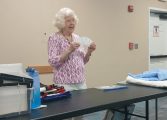By Page H. Gifford, Correspondent
“It’s really odd that I became an art teacher because I never studied art in high school. My life back then was all about the Thoroughly Modern Madrigals – a show choir directed by Jeff Suling,” said Carysbrook Elementary School art teacher Francesca Walker.
She has been teaching since 1998. A graduate of Fluvanna County High School, she attended Piedmont Virginia Community College, then transferred to Virginia Commonwealth University as a fine arts major with a concentration in fashion design. She graduated with a Bachelor of Fine Arts degree.
Approximately two years after graduating, she chose to change her career. She began substituting in the Fluvanna County Public Schools system where she grew up and then decided to pursue a career in education. She obtained a provisional teaching license and completed correspondence courses at the University of Virginia. Once she began teaching, she was hired by Fluvanna County Public Schools in a “split” position – half art and half Power Program.
 Working with third and fourth graders who are just on the cusp of understanding conceptual ideas takes a different approach to art.
Working with third and fourth graders who are just on the cusp of understanding conceptual ideas takes a different approach to art.
“I really enjoy teaching them a variety of art using various types of media,” Walker said. “I mostly enjoy completing three-dimensional projects with them. It seems to be what the majority of students like. I’m thrilled that most of them love art class.” Teaching art in three-dimensional forms is a good foundation for later work students will do on paper. Teaching them in this way helps them to see angles, proportions and perspective much more easily when they get to middle and high school.
In the past, students mainly learned by drawing on flat services and considering not what they actually saw but rather what they imagined. There was a gray area of confusion between reality, imagination and creativity, which did not always give students a solid base from which to learn.
Today’s art teachers take a more liberal approach to art by setting their students up with a firm foundation and exploring creativity.
“I try to emphasize that art is an experience, not just a picture you take home at the end of the day. Art helps you figure out who you are as a person – your likes and your dislikes. It helps you grow through trial and error,” said Walker. “I try to tell the students what I know to keep them from making mistakes, but encourage them to try whatever they have in their minds because that is the only way they will figure out if it works for them. If it doesn’t, then they can simply try again.”
Her method is sage advice for her students, and one that can be useful even to adults new to art, who need to learn that loosening up and enjoying the process is okay.
“Life is full of mess ups. Encouraging this way of thinking leads to open minds. This is important in art, but it’s even more important in today’s world,” Walker said. “I tell them that everything doesn’t have to be ‘cookie cutter’ and look like everyone else. It’s the people who think outside of the box that change the world – in most cases.”
This early learning is valuable in the visual arts. Walker teaches individualism and use of the imagination to create something unique rather than what the teacher dictates is correct.
In addition to allowing her students the freedom to explore and experience art, Walker also wants her students to remain respectful and polite with one another.
“I want them to have learned that it is okay to have a free spirit, but they also need to have a loving spirit. And, like you want others to respect and accept your free spirit, you need to respect theirs,” she said. “The only thing I’m trying to do is lead by example. I hope I’m doing okay with that.”




